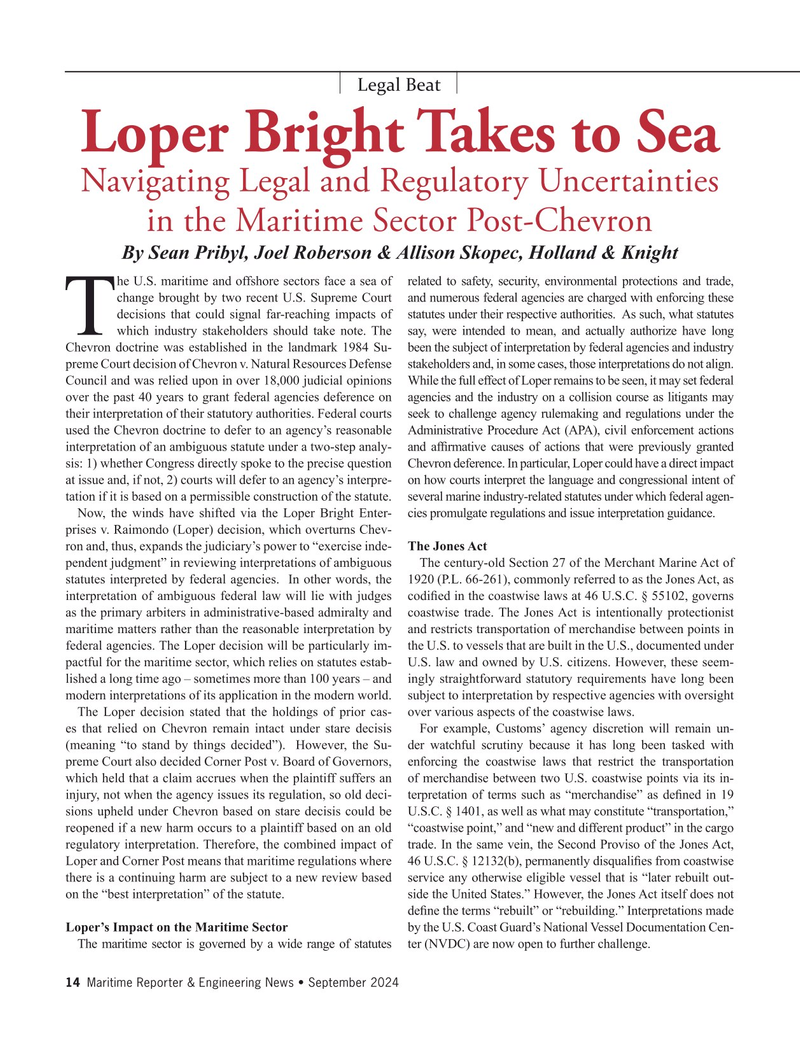
Page 14: of Maritime Reporter Magazine (September 2024)
Read this page in Pdf, Flash or Html5 edition of September 2024 Maritime Reporter Magazine
Legal Beat
Loper Bright Takes to Sea
Navigating Legal and Regulatory Uncertainties in the Maritime Sector Post-Chevron
By Sean Pribyl, Joel Roberson & Allison Skopec, Holland & Knight he U.S. maritime and offshore sectors face a sea of related to safety, security, environmental protections and trade, change brought by two recent U.S. Supreme Court and numerous federal agencies are charged with enforcing these decisions that could signal far-reaching impacts of statutes under their respective authorities. As such, what statutes which industry stakeholders should take note. The say, were intended to mean, and actually authorize have long
T
Chevron doctrine was established in the landmark 1984 Su- been the subject of interpretation by federal agencies and industry preme Court decision of Chevron v. Natural Resources Defense stakeholders and, in some cases, those interpretations do not align.
Council and was relied upon in over 18,000 judicial opinions While the full effect of Loper remains to be seen, it may set federal over the past 40 years to grant federal agencies deference on agencies and the industry on a collision course as litigants may their interpretation of their statutory authorities. Federal courts seek to challenge agency rulemaking and regulations under the used the Chevron doctrine to defer to an agency’s reasonable Administrative Procedure Act (APA), civil enforcement actions interpretation of an ambiguous statute under a two-step analy- and af? rmative causes of actions that were previously granted sis: 1) whether Congress directly spoke to the precise question Chevron deference. In particular, Loper could have a direct impact at issue and, if not, 2) courts will defer to an agency’s interpre- on how courts interpret the language and congressional intent of tation if it is based on a permissible construction of the statute. several marine industry-related statutes under which federal agen-
Now, the winds have shifted via the Loper Bright Enter- cies promulgate regulations and issue interpretation guidance.
prises v. Raimondo (Loper) decision, which overturns Chev- ron and, thus, expands the judiciary’s power to “exercise inde- The Jones Act pendent judgment” in reviewing interpretations of ambiguous The century-old Section 27 of the Merchant Marine Act of statutes interpreted by federal agencies. In other words, the 1920 (P.L. 66-261), commonly referred to as the Jones Act, as interpretation of ambiguous federal law will lie with judges codi? ed in the coastwise laws at 46 U.S.C. § 55102, governs as the primary arbiters in administrative-based admiralty and coastwise trade. The Jones Act is intentionally protectionist maritime matters rather than the reasonable interpretation by and restricts transportation of merchandise between points in federal agencies. The Loper decision will be particularly im- the U.S. to vessels that are built in the U.S., documented under pactful for the maritime sector, which relies on statutes estab- U.S. law and owned by U.S. citizens. However, these seem- lished a long time ago – sometimes more than 100 years – and ingly straightforward statutory requirements have long been modern interpretations of its application in the modern world. subject to interpretation by respective agencies with oversight
The Loper decision stated that the holdings of prior cas- over various aspects of the coastwise laws. es that relied on Chevron remain intact under stare decisis For example, Customs’ agency discretion will remain un- (meaning “to stand by things decided”). However, the Su- der watchful scrutiny because it has long been tasked with preme Court also decided Corner Post v. Board of Governors, enforcing the coastwise laws that restrict the transportation which held that a claim accrues when the plaintiff suffers an of merchandise between two U.S. coastwise points via its in- injury, not when the agency issues its regulation, so old deci- terpretation of terms such as “merchandise” as de? ned in 19 sions upheld under Chevron based on stare decisis could be U.S.C. § 1401, as well as what may constitute “transportation,” reopened if a new harm occurs to a plaintiff based on an old “coastwise point,” and “new and different product” in the cargo regulatory interpretation. Therefore, the combined impact of trade. In the same vein, the Second Proviso of the Jones Act,
Loper and Corner Post means that maritime regulations where 46 U.S.C. § 12132(b), permanently disquali? es from coastwise there is a continuing harm are subject to a new review based service any otherwise eligible vessel that is “later rebuilt out- on the “best interpretation” of the statute. side the United States.” However, the Jones Act itself does not de? ne the terms “rebuilt” or “rebuilding.” Interpretations made
Loper’s Impact on the Maritime Sector by the U.S. Coast Guard’s National Vessel Documentation Cen-
The maritime sector is governed by a wide range of statutes ter (NVDC) are now open to further challenge. 14 Maritime Reporter & Engineering News • September 2024
MR #9 (1-17).indd 14 9/2/2024 10:03:57 PM

 13
13

 15
15
